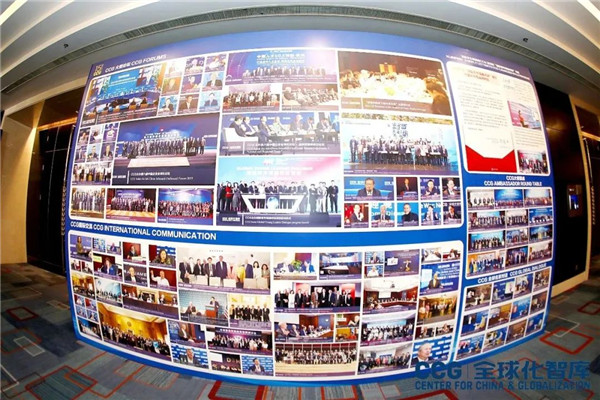Transcript: Opening Global Talent Summit 2025
June 27 , 2025Ambassadors, municipal officials, international organisation representatives, and think tankers highlight cross-border cooperation and innovation, amid Beijing city’s wish to attract global talent.
▲ Video | Opening ceremony@Global Talent Summit 2025
The Global Talent Summit 2025 opened on June 27 at the Beijing International Wealth Centre in Tongzhou, the capital’s sub-centre district. Co-hosted by the Alliance of Global Talent Organisations (AGTO) and the Centre for China and Globalisation (CCG), the event is supported by the Beijing Municipal Bureau of Talent Work and the Tongzhou District Government.
During the summit, the AGTO Beijing Representative Office was officially inaugurated. The event also saw the release of the report Global Talent Flow: Trends and Prospects 2025.
Speakers at the opening ceremony were:
Mabel Lu Miao, Chief Representative, the AGTO Beijing Representative Office; Secretary-General, the Centre for China and Globalisation (CCG)
LI Chenglin, Standing Committee Member & Head of the Organisation Department, Beijing Municipal Party Committee
Denis Simon, Chairman, Global Talent Organisations (AGTO)
He Xian, President, China Talents Society; Former Vice Minister of Human Resources and Social Security of China
Tamas Hajba, Senior Advisor for China & Head of the Beijing Office, Organisation for Economic Co-operation and Development (OECD)
Henry Huiyao Wang, Founder and President, CCG; Secretary-General, AGTO
The opening roundtable, moderated by Henry Huiyao Wang, featured:
Thórir Ibsen, Ambassador of Iceland to China
Kārlis Eihenbaums, Ambassador of Latvia to China
Abdelkader El Ansari, Ambassador of Morocco to China
Khalil Hashmi, Ambassador of Pakistan to China
Paulo Jorge Nascimento, Ambassador of Portugal to China
Balthasar Staehelin, Personal Envoy of the President to China; Head of the Regional Delegation for East Asia, International Committee of the Red Cross (ICRC)
Marti Mätas, Chargé d´Affaires a.i., Embassy of Estonia in China
Li Wen, Chief of Mission in China, the International Organisation for Migration (IOM)
Tamas Hajba, Senior Advisor for China & Head of the Beijing Office, Organisation for Economic Co-operation and Development (OECD)
Zhao Bing, Representative and Country Director, World Food Programme (WFP) China Office
Guo Ruijun, Deputy Director, Exit-Entry Administration of Beijing Municipal Public Security Bureau
Siddharth Chatterjee, UN Resident Coordinator in China (joined via video)
Scott MacEachern, Professor of Archeology and Anthropology & Vice Chancellor for Academic Affairs, Duke Kunshan University
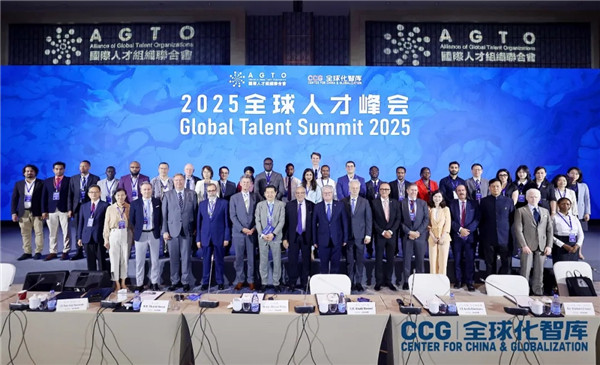
This transcript is based on the video recording and has not been viewed by any of the speakers.
Mabel Lu Miao, Chief Representative, the AGTO Beijing Representative Office; Secretary-General, the Centre for China and Globalisation (CCG)
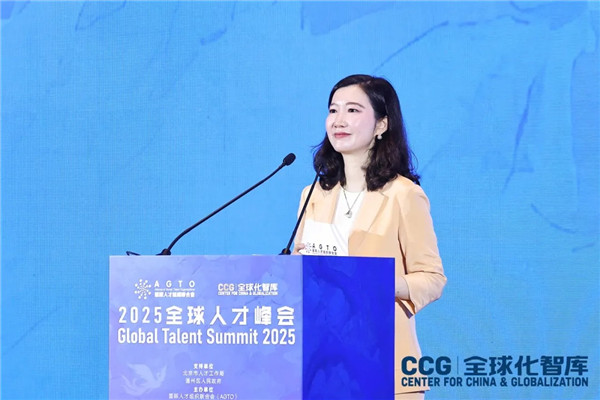
[Speaking in Chinese]
Your Excellencies, distinguished ambassadors, representatives of international organisations, honoured guests, ladies and gentlemen, good morning.
I am Lu Miao, Chief Representative of the Beijing Office of the Alliance of Global Talent Organisations (AGTO). It is my great honour to host the opening ceremony of the 2025 Global Talent Summit. On behalf of AGTO, I would like to extend my warmest welcome and heartfelt thanks to all the distinguished guests attending the summit.
AGTO is an international organisation jointly initiated by the Centre for China and Globalisation (CCG) and renowned international experts. Its mission is to promote global talent exchange and cooperation, facilitate policy dialogue, and foster broad consensus on mutually beneficial international talent collaboration. AGTO achieves this through organising the Global Talent Summit, publishing research reports on global talent mobility trends, and other activities.
This year’s Global Talent Summit is co-hosted by CCG and AGTO, under the theme “Global Wisdom, Future Prosperity.” The aim is to build a globally interconnected platform for talent exchange and cooperation, bringing together resources and empowering Beijing as a centre for international engagement, scientific innovation, and high-level talent.
Allow me now to introduce our distinguished guests attending the opening ceremony:
Li Chenglin, Member of the Standing Committee and Head of the Organisation Department of the Beijing Municipal Party Committee
Dennis Simon, Chairman of the Alliance of Global Talent Organisations
He Xian, President of the China Talents Society and former Vice Minister of Human Resources and Social Security of China.
I kindly ask everyone to hold your applause until I have finished introducing all our guests.
A warm welcome also to our distinguished international guests:
Tamas Hajba, Senior Advisor for China & Head of the Beijing Office at the Organisation for Economic Co-operation and Development (OECD)
Paulo Jorge Nascimento, Ambassador of Portugal to China
Abdelkader El Ansari, Ambassador of Morocco to China
Kārlis Eihenbaums, Ambassador of Latvia to China
Khalil Hashmi, Ambassador of Pakistan to China
Thórir Ibsen, Ambassador of Iceland to China
Marti Mätas, Chargé d’Affaires and Deputy Head of Mission of the Embassy of Estonia
Li Wen, Chief of Mission in China of the International Organisation for Migration (IOM)
Balthasar Staehelin, Personal Envoy of the President for China and Head of Regional Delegation for East Asia at the International Committee of the Red Cross (ICRC)
Zhao Bing, representative and country director of the World Food Programme (WFP) China Office
From Beijing, we are joined by:
Zhang Ruobing, Deputy Head of the Organisation Department of the Beijing Municipal Party Committee and Director-General of the Beijing Municipal Talent Work Bureau
Wei Xubin, Deputy Director of the Beijing Municipal Education Commission
Yang Pu, Deputy Director of the Beijing Municipal Science and Technology Commission and the Administrative Commission of Zhongguancun Science Park
Meng Jingwei, Secretary of the Tongzhou District Party Committee.
We are also joined by representatives from central government agencies and internationally renowned institutions, as well as leaders from the Beijing Municipal Bureau of Commerce, Bureau of Culture and Tourism, Exit-Entry Administration and Office for Foreign NGOs at the Beijing Public Security Bureau, Beijing Overseas Talents Centre, relevant commissions and bureaus from the Tongzhou District Party Committee and Government, and friends from the media.
Let us once again extend a very warm welcome to all the leaders and distinguished guests here today. Welcome, all of you.
Now, it is my great honour to invite Mr. Li Chenglin, Member of the Standing Committee and Head of the Organisation Department of the Beijing Municipal Party Committee, to deliver the opening address. Please welcome Mr. Li.
Li Chenglin, Standing Committee Member & Head of the Organisation Department, Beijing Municipal Party Committee
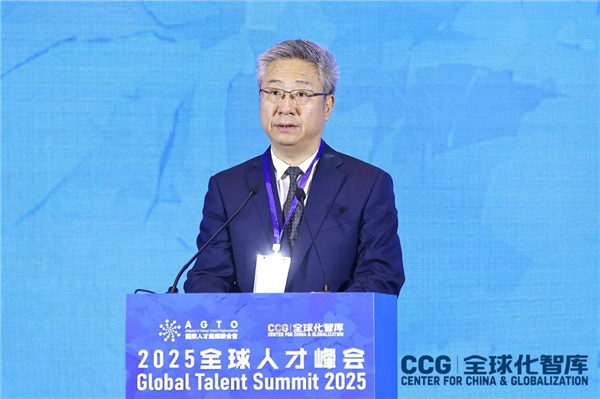
Denis Simon, Chairman, Alliance of Global Talent Organisations (AGTO)

Your Excellency, Mr. Li, Your Excellency, Mr. He, Mr. Tamas Hajba, distinguished guests, ladies and gentlemen, good morning to you. 早上好,
It’s an honour to help launch this conference on global talent development and trends, because it’s such an important subject. My name is Denis Simon, and I’m the chairman of the Alliance of Global Talent Organisations. Let me begin by thanking our sponsors and the speakers today for supporting this event at a truly consequential moment of time in world history. In particular, I want to thank the Beijing Municipal Government for having the vision and the viewpoint to create such an exciting opportunity for a group of serious international professionals like yourselves to come together to discuss the cutting-edge issues related to global talent.
We are standing at the intersection of an intensive technological disruption, a large demographic transition, and much geopolitical uncertainty. This is a time when talent is no longer just a labour market issue; it has become much more than that, particularly given the emphasis on innovation in the world today. Talent is a strategic asset. It’s also a national capability, and increasingly, it’s a matter of policy sovereignty.
Let me pose a question that I hope will help shape our discussion over the rest of the day: Are our current talent systems, which were designed largely for an industrial era, capable of managing a post-industrial AI-powered world? Do we have the right elements in place? Do we have the right viewpoints in place? Do we have the right people in place? If we’re honest, the answer is probably not yet. But that opens the door for what I hope will be some really bold thinking and perhaps even bolder reforms.
Let’s start and look at some of the key trends that will shape the way we shape our new policies and put them into practice. The first trend involves what I call the rise of the augmented workforce. We are entering an age of human-machine complementarity. AI systems are accelerating from narrow tools to general-purpose infrastructure. Robotics is redefining physical labour, and quantum computing promises to upend data processing and cybersecurity as we know it. But this is not just a technological story; it is a major talent policy challenge. Governments now must think beyond traditional employment models because we are seeing the rise of this augmented workforce, where humans and algorithms collaborate across multiple economic sectors.
Policy, therefore, must shift accordingly. Workforce development in each of our countries needs to emphasise adaptive learning, not one-time credentials. The idea that you go to college for four years and have the knowledge that’s going to take you for a 30-year career, that kind of perspective is simply obsolete. Labour Statistics today must track hybrid roles and digital skills, and not just traditional job classifications. And funding, most importantly, must support lifelong learning and re-skilling as public goods and not just as private burdens.
The second trend I want to talk about is the view of talent as a national security and competitiveness issue. The global competition for talent today is no longer an abstract idea. It is now intensely geopolitical. The countries that lead in science, AI, biotech, quantum, etc, will be those that attract, cultivate, and retain top talent, not just from within, but across borders and across cultures. Look at countries such as Singapore, Canada, Germany, and the UAE. They’ve moved aggressively to align immigration, education, and innovation policy under a unified talent strategy. Meanwhile, unfortunately, some nations are imposing restrictions that hamper their own competitiveness, by limiting visa access, by tightening export controls and by cutting research ties under the banner of national security.
Security matters; of course, it matters. But isolation is not a strategy. We need what I call smart openness, not a strategic retreat from global engagement. The United States, the European Union, and others must revisit their approach to these ideas. Visa systems that are outdated for today’s highly mobile project-based STEM world must now be changed. They are clogging the way we can find answers to the solutions and problems that stand before us. And research ecosystems today are being weakened by political mistrust. The name of the game is collaboration, not decoupling.
The third trend I want to talk about is the platformisation and decentralisation of global talent. We are witnessing what we might call the unbundling of work, and this is a very, very important trend. Talent is increasingly organised through platforms, not through companies. Remote teams that build across time zones are now the real action entities. Digital credentials are issued by AI-powered assessment tools, and micro-entrepreneurs are reshaping labour supply chains and work supply chains.
For policymakers, this raises some very urgent questions: How do we regulate work that crosses borders but not jurisdictions? How do we tax income that isn’t earned in a physical office? How do we ensure social protections for health care, pensions, fair wages for workers who never enter a traditional firm? This indeed is the new frontier: global labour platforms that define national boundaries but still demand some type of national policy response.
Policy makers, therefore, must collaborate to create solutions. Mutual recognition frameworks for skills and credentials now must come together. Portable benefits across jobs and borders must be realisable and digital infrastructure standards that enable fair participation from the Global South must be established and must be sustainable.
The fourth trend I want to mention is inclusion, equity, and the talent dividend. In some places, these words are no longer very popular, but none of what I’m talking about will succeed unless indeed we have inclusive policies. The global talent revolution must avoid repeating the problems and failures of the past industrial revolutions, where opportunity was uneven, access was restricted, and innovation actually widened inequality.
We must ask: Are we ensuring that women, displaced workers, and underrepresented groups can access AI-era skills? Are we designing our immigration pathways for climate migrants and not just for the technical elites of the world? Are we empowering the youth bulge that’s occurring in Africa and South Asia, where the next billion workers are going to come from? Governments must adopt their policies that treat inclusive talent development not as charity but as a geostrategic investment in the prosperity of the planet. The talent dividend is real, no doubt, but it only pays off if it is equitably distributed and managed.
In closing, let me make the following points. Simply stated, we are not just talking about upgrading labour markets. We are laying the foundation of a new global talent architecture. This clearly will require a number of things: Regulatory innovation that is bold, the technological changes that are occurring, and these regulatory changes must govern. Cross-border cooperation that builds on the trust that needs to occur to facilitate talent mobility, and strategic foresight that anticipates the kind of disruption we are seeing today. We must not just simply react to it; we must anticipate it and act accordingly.
If the 20th Century was defined by capital mobility, the 21st Century needs to be defined by talent mobility, and how well our policies enable it or constrain us. Let us stop asking whether we can keep up with the change. Let us accordingly ask how we can shape the change and, ultimately, how we can harness these changes. My organisation, AGTO, hopes to play a central role as a bridge builder in bringing together the necessary expertise and know-how to assist in this critical effort. Let me thank you again for coming to our meeting and for willingly participating in our activities. And welcome to the conference. And now let’s get to work. Thank you very much.
He Xian, President, China Talents Society; Former Vice Minister of Human Resources and Social Security of China
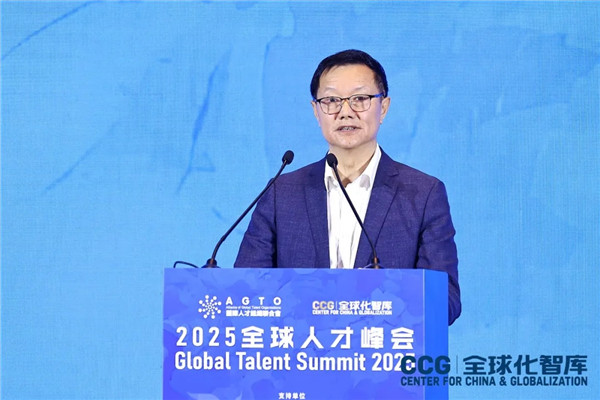
[Speaking in Chinese]
Distinguished guests, dear friends, good morning. We are living in an era where the role of talent is more prominent than ever, especially in the age of high technology. Against this backdrop, it is impossible to overstate the importance of talent. I am very pleased to have the opportunity to participate in the 2025 Global Talent Summit, and I would like to take this chance to share some thoughts on talent service institutions.
Under a market economy, the rational allocation of talent resources is closely tied to the development of talent service institutions. Wherever talent mobility is active and talent-driven innovation is strong, the talent service industry tends to be prosperous. In China, this industry developed relatively late. During the planned economy era, talent was uniformly assigned by the state, and there were no talent service institutions. Following the reform and opening up, talent mobility emerged, ushering in the beginning of the talent service sector. In the early days, government-run agencies dominated the field. It wasn’t until the 1990s that private and foreign-funded talent service organisations began to grow. Since the turn of the century, various types of talent service institutions in China have expanded rapidly. By the end of 2023, there were nearly 70,000 human resources service institutions nationwide, employing 1.05 million people, and generating revenue of 2.75 trillion yuan.
Talent service institutions provide intermediary services to job seekers and talent solutions to employers. They play a crucial role in ensuring the rational allocation, mobility, and utilisation of talent resources in China. These institutions are indispensable to both economic development and social progress.
Beijing has long been a leader in talent services across China. As early as the beginning of the reform and opening up, the Beijing Talent Service Centre emerged as a national model with significant influence. In 1995, the Beijing Municipal Government issued the “Regulations on the Management of the Talent Market in Beijing,” becoming the first in the country to separate regulation from operation in the talent market. This created essential conditions for fair competition in the talent market.
Private talent service enterprises in Beijing have risen rapidly, and joint ventures and foreign-funded talent services have also seen healthy development. Over the years, talent service providers in Beijing have remained at the forefront nationally, offering comprehensive services to individuals, enterprises, and other employers, and contributing significantly to the city’s social and economic development.
China’s talent service sector has developed by focusing on practical social and economic needs while learning from the experience of developed market economies. A complete set of service methods and systems tailored to China’s national conditions has now taken shape. Overall, the industry has kept pace with national socioeconomic progress, but there is still room for improvement. Especially as the central government sets new goals for talent work, talent service institutions face fresh challenges and must accelerate their development.
First, talent service institutions must proactively serve national strategies. The 20th National Congress of the Communist Party of China proposed a series of workforce development strategy plans and tasks in the new era, such as building a contingent of personnel with expertise of strategic importance and building world hubs for talent and innovation. Talent institutions have an important role to play in this process. They should be encouraged to leverage their strengths, proactively serve national strategies, align their development with national strategies, and find new growth opportunities by serving these broader goals.
Second, innovation in the service sector must be intensified. Rapid technological advancement is a hallmark of our era and brings opportunities for revolutionary changes in all fields. At present, most talent service institutions still rely heavily on traditional services and compete excessively in low-tech areas like staffing. However, their development in emerging areas is insufficient. More investment in technological R&D is needed. Institutions should be encouraged to actively explore technologies such as AI and big data. Large talent service firms should establish dedicated R&D departments and partner with universities and research institutes to develop proprietary HR technologies and tools that will enable the industry to adapt to the high-tech era.
Third, continued encouragement and support should be given to the development of private talent service institutions. As part of the service sector, these organisations often enjoy certain advantages in specific areas. Practice has shown that private firms have made unique contributions in fields such as high-level talent acquisition. We must place trust in these institutions, implement the Private Economy Promotion Law in earnest, and create a level playing field for them. Leveraging their flexible mechanisms and strong capacity for innovation will help inject vitality into the industry.
At the same time, bolder steps must be taken to “go global.” Talent exchange and cooperation are integral parts of the Belt and Road Initiative. Talent service institutions going global can support not only Chinese enterprises but also companies in Belt and Road countries. As a standalone industry, the talent service sector has reached a stage of basic maturity and is now well-positioned to go global.
Not long ago, I attended a forum in Shanghai focused on the internationalisation of talent service institutions. I witnessed how Shanghai has made significant explorations in supporting Chinese enterprises going abroad and contributing to the Belt and Road Initiative. This “going global” not only aids in economic development along the Belt and Road but also creates new growth space for the institutions themselves. The potential is vast.
Comrades and friends, talent services are a vital component of broader talent development work. All sectors of government should value and support the growth of this industry. I believe that as the Chinese economy and society continue to develop and embrace higher levels of openness, talent service institutions will have a broader stage and play a more significant role. I also hope that all types of talent service organisations will leverage their strengths and work together to contribute more to the implementation of the workforce development strategy in the new era.
Tamas Hajba, Senior Advisor for China & Head of the Beijing Office, Organisation for Economic Co-operation and Development (OECD)
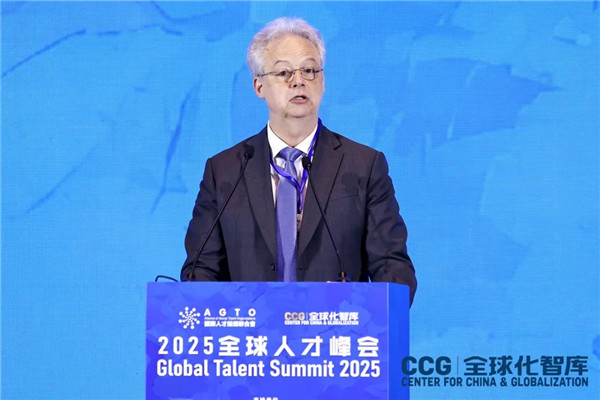
Your Excellency, Mr. Li Chenglin, President Simon, President Wang, ambassadors, ladies and gentlemen, good morning. First of all, thank you for the invitation, and I’m pleased to join the Global Talent Summit and discuss global talent mobility. I would also like to thank the Beijing Municipal government for its support to the dialogue on this critical topic.
People, ideas and money are moving across countries at a speed that has never been seen before. This has made the world more connected and active than ever before. Countries must stay proactive, strategic and flexible in order to use these flows to their advantage for long-term economic growth, innovation, and success.
Let me begin by putting this issue into the context of migration. Since 2010, the proportion of the world’s population living outside their countries of birth has steadily increased. Within OECD countries alone, this share rose from 8.9% in 2012 to over 10% by 2022. Now, this may seem incremental at first sight, but these figures represent tens of millions of people, professionals, students, entrepreneurs, investors. And their contributions are vital to their host countries, economies, and societies.
More than that, the skill profile of migrants is rapidly evolving. Since 2010, the share of highly educated individuals among immigrants in OECD countries has increased by 10 percentage points. This trend underscores a decisive shift in international migrations. Today’s migrants are often highly qualified professionals who can fill skill gaps, foster innovation, and boost productivity. Many of these talented people originate from Asia, especially from China and other countries, home to a growing middle class and top-tier education institutions.
If we look at the migration trends in recent years, we can see the impact of this growing demand. Permanent-type migration to OECD countries hit a record level in 2022 with 6 million new permanent immigrants. This represents a 14% growth relative to the pre-pandemic year of 2019. Labour migration accounted for a substantial part of this surge, with permanent labour migration growing by 21% and temporary labour migration by 77%. And this is not a short-lived spike. Provisional data and data for 2023 show that this upward trajectory is continuing.
So, the question for many advanced and emerging economies is how to make their countries more attractive and accessible to international talent as competition intensifies. And the competition is fierce. The ManpowerGroup reported that global talent shortages have hit a 17-year high in 2023. Labour markets face persistent shortfalls in engineering, IT, healthcare, renewable energy, and other critical sectors. Every OECD country is responding by offering tailored admissions channels to attract highly skilled migrants, including dedicated visa programmes for tech workers, tax incentives for returning nationals, and specialised pathways for entrepreneurs. More recently, we have also seen the proliferation of so-called Start-up Visa programmes.
Now, these may vary considerably across countries in terms of target groups, eligibility criteria and support services, but all reflect a recognition that entrepreneurship and innovation thrive on a diverse and globalised ecosystem.
Importantly, international students play a pivotal role in this mobility story. The OECD’s latest figures showed that approximately 4.5 million international students were enrolled in tertiary education across its member states. Some of them are coming from Asia and contribute significantly to the academic vibrancy and research capacity of their destination countries. Destination countries recognise the close link between international student inflows and future skilled supply. Many have introduced policies allowing international graduates to stay on and work after completing their studies, seeing these students also as a key source of future talent.
Indeed, the data show us a strong correlation between international student mobility and permanent migration. A substantial proportion of international students remain after graduation, becoming part of the skilled labour force and driving innovation, research, and economic dynamism. Whether through generous post-study work rights, streamlined recognition of qualifications and diplomas, or targeted recruitment drives for graduates in shortage occupations, countries are actively leveraging this talent pipeline.
That brings me to the issue of branding and attractiveness. The OECD indicators of talent attractiveness reveal that talent mobility decisions are driven by more than just salary and career progression. Factors like work-life balance, quality of public services, cultural vibrancy, ease of integration, and inclusive and welcoming societies play a decisive role. As competition intensifies, branding is becoming even more important. Countries need to position themselves as safe, dynamic, opportunity-rich societies. They must also streamline administrative procedures and digitalise immigration systems to enhance the user experience for applicants and employers alike.
Yet, attracting and retaining global talent is not only about skilled professionals and students. It is also fundamentally linked to broader international openness and the appeal of the destination as a whole. This is where tourism and destination marketing come into play. According to the OECD Tourism Trends and Policies report, global tourism is recovering rapidly post-pandemic; international arrivals have rebounded to nearly 90% of the pre-pandemic level; projected growth driven by increased connectivity, digital innovation, and changing traveller preferences.
Countries that successfully attract international tourists tend to benefit from spillovers into talent attraction, as the tourists become familiar with the culture, infrastructure, and opportunities available. Our report emphasises that sustainable tourism policies, such as investing in green and cultural assets, improving visitor services, and strengthening local economies, help countries enhance their global reputation.
The OECD research also underscores the role of major cities as hubs for both tourism and talent attractiveness. Capital Cities leverage their cultural offerings, ease of mobility, and vibrant international communities to attract millions of tourists and a steady inflow of highly-skilled workers. These cities show that tourism and talent policies can and actually should be closely integrated into a coherent policy.
In this context, I would like to highlight the measures taken by the Chinese government, also by the Beijing Municipal Government, to bolster its global competitiveness as both a talent magnet and a tourist destination. Beijing has launched a set of initiatives to attract top-tier international professionals in cutting-edge fields such as green technology, green energy, AI, biomedical research and financial services. These measures also include a simplified visa process for foreign experts and researchers and an expanded Green Card programme for long-term residents, and one-stop service centres that help overseas professionals navigate administrative requirements.
In addition, Beijing is also investing in its cultural and tourism infrastructure to enhance its international appeal. The government has streamlined visa procedures for short-term visitors, promoted multilingual tourism services, and curated cultural festivals and international sporting events to draw global audiences. The city is also expanding its smart tourism offerings, leveraging digital platforms and data analytics to improve visitor experiences.
But these measures recognise that talent and tourism are two sides of the same coin. International visitors often become ambassadors and potential future investors or employees, and a city that is welcoming to tourists is more likely to be welcoming talented professionals and their families.
Moving forward, the most successful countries and cities will be those that take a holistic, forward-thinking approach, one that integrates migration policies with labour strategies, educational and research capacity, urban planning, and tourism development. Strengthening administrative processes, improving branding and marketing, facilitating the recognition of foreign skills and credentials, and investing in the amenities that make cities and countries attractive places to live and visit—all these are elements of a coherent, strategic talent and tourism agenda.
And as we look to the future, the role of returning immigrants and diasporas must not be overlooked. These returnees often serve as bridges to global networks, boosting trade and innovation, and enhancing international tourism and cultural exchanges.
Ladies and gentlemen,
The landscape of global mobility is shifting rapidly. What was once a mostly passive process is becoming a highly strategic with countries, regions, and cities actively crafting policies to attract and retain talented people, welcome visitors. This again requires a holistic, evidence-based approach that integrates migration, tourism policies into broader strategies for sustainable growth, innovation and inclusiveness. International cooperation, including the sharing of data, information, and best practices, is becoming increasingly crucial. Every country has a unique asset and experience. So the exchange of ideas, policies, practices benefits everyone.
At the OECD, we will continue to support countries as they navigate these challenges. Our indicators, such as the Talent Attractiveness Indicator, international migration reports, and tourism trends analysis, offer robust data and analysis to inform policy decisions. So, let us continue to work together, use the excellent platform of the Alliance of Global Talent Organisations to foster more inclusive, vibrant, and talent-rich societies. Thank you for your attention, and I very much look forward to our discussions today.
Henry Huiyao Wang, Founder and President, CCG; Secretary-General, AGTO
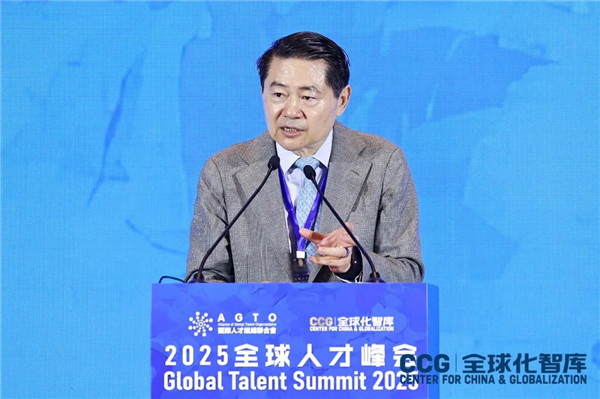
[Speaking in Chinese]
Your excellencies Li Chenglin, He Xian, ladies and gentlemen:
Today I’m pleased to present the Global Talent Mobility Trends Report 2025. This report represents a major research initiative that the AGTO has been devoted to for some time. We will continue to increase our influence in this area in the future. Due to time constraints, I’ll provide a brief overview.
We have been tracking international talent mobility and development for quite some time. This report presents a comparative analysis of talent competitiveness across 38 countries, based on a wide range of relevant data. Our goal is to support policy decisions, understand our own progress, identify gaps, and contribute to the construction of a better global talent order. We created a system called the “The Talent Competitiveness Index for Major Countries,” which evaluates talent competitiveness in 38 nations. These countries were selected based on their population size and share of global GDP. We sourced data from the World Bank’s World Development Indicators, the World Intellectual Property Organisation, the International Labour Organisation, the Fortune Global 500, global university rankings, and, in some cases, national statistical authorities.
This is a comprehensive index based on each country’s talent data. We independently developed a set of evaluation criteria covering five primary indicators: talent scale, talent quality, talent environment, talent input, and talent performance, supported by 14 secondary indicators. Due to time limitations, I won’t elaborate on these. You can scan the QR code for the full report.
Overall, the United States remains the global leader in talent competitiveness, while South Korea also performs strongly. As a major country, China has been rising steadily in the rankings over the past two years. Currently, four Asian countries are in the global top ten, with China ranking fifth. In terms of talent scale, China and the U.S. show clear advantages. China may be the most promising and competitive country. On indicators such as intellectual property output, China has caught up with or even surpassed the U.S. in some areas.
In terms of talent quality, South Korea, Canada, and Sweden lead the rankings. As an international organisation, AGTO applies objective criteria to release these indicators globally.
When it comes to talent environment, the United States and China have clear advantages. We are pleased to see that in recent years, China has made remarkable progress in these areas and has already surpassed many developed countries.
Regarding talent input, China has made substantial input, but there remains considerable room for further improvement. The United States, of course, also invests heavily in this area.
As for talent performance, there is still some distance for China to cover—this is evident. In Asia, Singapore stands out, with South Korea following closely behind. Countries such as Ireland and Switzerland are also not far apart in this regard.
Overall, China now ranks fifth in global talent competitiveness—a significant improvement—with the largest talent pool in the world. That summarises the current situation.
The second part of the report examines “The Present Status and Trends in Global Talent Flow.” International migration is growing rapidly. Among the world’s 8 billion people, 300 million are international migrants, representing 3.7% of the global population. Of these, 150 million are labour migrants, making up 62% of the total.
The number of international students continues to expand. From 2.1 million in 2000, the number rose to 6.86 million in 2022, outpacing the growth rate of university enrolment overall. Although there was a slight decline after the pandemic, the figure remains high, and students from middle-income countries are becoming more prominent. China remains the world’s largest source of international students, accounting for over 60%, followed closely by India—which has now surpassed China in the U.S. High-income countries and regions attract 75% of all international students. Meanwhile, the number of international students studying in China is also on the rise.
Talent mobility in the digital era is also accelerating, particularly in the field of AI. Approximately 50% of global AI talent is ethnically Chinese, and 30% of AI professionals in the U.S. are Chinese. This high mobility reflects the fierce global competition for top talent. In the U.S., some recent policies of the Trump administration have triggered talent outflows, creating new opportunities for other countries. Japan, China, and Germany are enhancing their talent recruitment systems. China is actively exploring skilled immigration policies and currently offers unilateral visa-free access to 47 countries, while Hainan has extended this to 80. As a result, many professionals may choose to live or work in China. High-skilled talent is indeed flowing toward China.
Finally, I would like to offer a few brief recommendations:
First, it is essential to promote the orderly flow of global talent. As an international talent organisation, AGTO aims to deepen the understanding of the value of talent mobility.
Second, it is essential to drive talent mobility through high-level opening up. As Mr. Li Chenglin mentioned earlier, nationwide efforts are underway to open up further, and talent mobility at a high level can drive high-level development overall.
Third, it is essential to build multi-tiered platforms for talent exchange and dialogue. For instance, today’s Global Talent Summit held here in Beijing’s sub-centre aims precisely to expand such multi-level exchange spaces.
Fourth, it is essential to promote the diversification and digitalisation of talent migration governance platforms. Later, we will release outcome reports and mechanism-building updates to support the creation of a digitally driven global skills recognition and talent migration governance system.
Note: The above text is the output of transcribing from an audio recording. It is posted as a reference for the discussion.
Related:
Global Talent Summit 2025 Holds in Beijing Sub-Center
Alliance of Global Talent Organizations Beijing Office Opening
Report: Global Talent Flow: Trends and Prospects 2025
